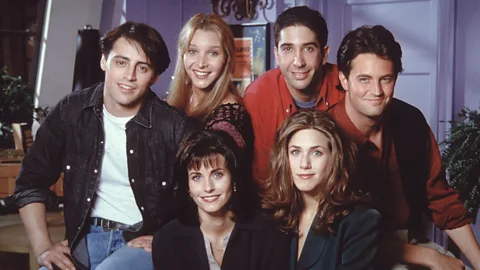 Alamy
AlamyFirst broadcast 30 years ago this week, the hugely popular show Friends became much more than a sitcom – it brought a new way of living into the mainstream.
Barely three minutes into the pilot episode of Friends (The One Where Monica Gets a Roommate), the audience gets introduced to Rachel Green – played by Jennifer Aniston – as she bursts through the doors of the now universally recognised Central Perk in her wedding dress, having hotfooted it straight from the altar, leaving behind her orthodontist fiancé Barry.
She’s run away from her potential domestic set-up – married at 24 to a man she didn’t love – to search for an alternative life in the big city. Later in the episode, she sits at her high-school friend Monica Geller’s kitchen table as the others encourage her to cut up the credit cards paid for by her father. It’s a symbolic severing of ties to her family as she starts a new life in the city with Monica, Phoebe, Chandler, Joey and Ross. “Welcome to the real world,” says Monica. “It sucks. You’re going to love it.”
In that opening episode, which premiered 30 years ago this month, Friends let its audience know exactly what the show would be about. Marriage was abandoned (or, in Ross’s case, over not long after it had begun). Parents were out of the picture. The people these characters would rely on every week were each other. They were six slightly clueless twenty-somethings muddling their way through relationships, jobs and life. Not sure where they were heading, but not too worried about it either.
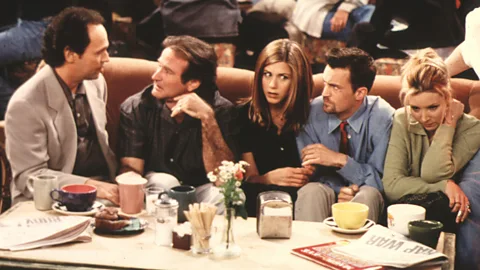 Alamy
AlamyA year earlier, in 1993, Marta Kauffman and David Crane had pitched their show about a group of friends to NBC, a network on the hunt for something to capture the attentions of a young, urban audience. In his new book Still Friends, which provides a forensic history of the show, Saul Austerlitz writes that NBC wanted to find a show to ape the success of Seinfeld – also about a group of friends living and working in New York. In the early 90s, with sitcoms like Roseanne, Full House, The Fresh Prince of Bel Air and Mad About You still focused on family and married life, Seinfeld’s set-up was still a rarity – though that summer Living Single, about a group of black friends sharing a Brooklyn brownstone townhouse, premiered on Fox. There was clearly an audience for TV reflecting a reality of young people’s lives: that they spent more time with friends than family.
That’s what friends are for
Kauffman and Crane had not long moved to LA, leaving behind their own group of close-knit friends in New York City. This – combined with Kaufmann driving past a LA coffee shop full of mismatched furniture, battered sofas and groups of young people hanging out – had sparked the idea. Their pitch read: “It’s about friendship because when you’re single and in the city, your friends are your family.”
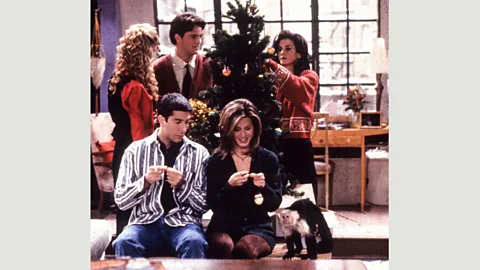 Alamy
AlamyIt’s made clear early in Friends’ run just why the six characters need each other. In the second episode, Phoebe talks about her mother’s suicide and Rachel discovers her parents are getting a divorce. The Geller parents come to visit, fawning over Ross but constantly putting down Monica (“I read about these women trying to have it all and I thank God, our little Harmonica doesn’t seem to have that problem,” says her dad). Later in the series Joey discovers his father is cheating on his mother and Chandler reveals that his parents announced their divorce during Thanksgiving dinner when he was nine years old.
It’s in that first Thanksgiving episode, as the six have their individual plans foiled and end up eating grilled cheese together in Monica’s apartment, that it becomes clear: families are messy and unreliable; it’s your friends you can depend on. “This was nobody’s first choice,” says Joey. And yet, from now on, they’ll always spend the holiday together.
Many elements of Friends were fantastical – underemployed adults living in enormous Greenwich Village apartments for one – but the idea of constructing an alternative family from friends was one that resonated. After divorce rates peaked in the previous decade, many of those entering adulthood in the 90s came from broken homes, and they were holding off on matrimony themselves, with the average age for getting married creeping up each year.
“There are complicated parental relationships going on in the background in Friends to kind of frame this coming-of-age and that’s certainly one of its appeals,” says Neil Ewen, a senior lecturer at Winchester University’s School of Media and Film. “You’re growing older and becoming an adult, you have problems with your parents, and you look to your friends for support. It’s a universal theme.”
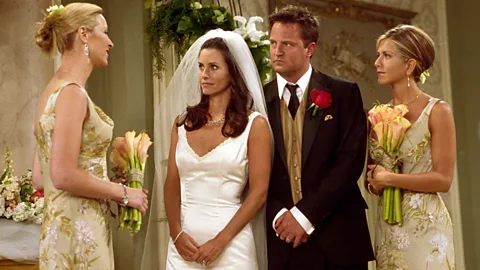 Alamy
AlamyTwenty-somethings were living a prolonged adolescence – too old to live with their own families, too young to have one of their own. It was friends who were filling the gap – in real life and on screen. Through bad relationships, hook-ups, dodgy career moves, weddings, divorces, babies and parental fall-outs, the six characters on Friends were there for each other, even as some pairings moved from platonic to romantic – and back again (but were they on a break?).
The idea of friends as the new family wasn’t the only way the show challenged domestic norms. Over the course of 10 seasons, its storylines covered same-sex marriage, infertility, adoption, surrogacy and single parenthood. It didn’t always get it right – and much has been written about its treatment of certain issues, particularly Chandler’s transgender father. Kauffman has said the show’s transphobic jokes and portrayal of Helena – played by Kathleen Turner – is the one aspect she’d most like to go back and change.
Friends managed to be simultaneously progressive and regressive. The show famously lacked diversity – yet featured several interracial relationships matter-of-factly. Too often homosexuality was played for laughs, yet it in its second season it was one of the first US sitcoms to show a same-sex wedding – and featured real-life gay rights activist Candace Gingrich officiating.
It tackled things clumsily – but it did tackle them. “What’s interesting about Friends is that it goes down all these different routes, addressing these cultural issues, but it does it under the cover of this kind of gentle comedy,” says Ewen. “It represented and gave voice to those issues for a wide audience.”
It was never radical – but it wouldn’t have been one of the most popular shows on TV if it was, says Ewen. Austerlitz argues that it was precisely because Friends never strayed too far from the middle-of-the-road that made these representations so important. “In its embrace of the aggressively normal in its storytelling, it was able to expand the spectrum of normalcy until it could also include a lesbian wedding,” he writes.
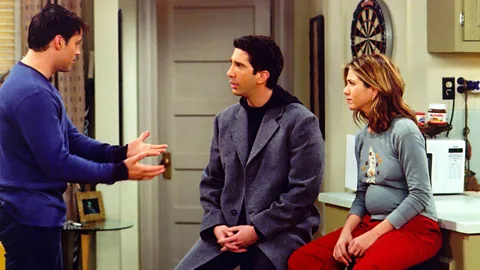 Alamy
AlamyYet, however much Friends pushed the boundaries of what family could look like it was, traditional values ultimately won out. In 2004’s finale, Rachel sacrifices her career to return to Ross and raise their daughter together. Monica and Chandler get the babies they longed for and move to the suburbs. Phoebe has married Mike. Only Joey is still single – conveniently for the spin-off sitcom, Joey, that was to follow.
For younger viewers, it might be hard to fathom a world in which friends hang out every day physically… or rather, IRL (in real life). “I think Friends speaks to that sense that we’re feeling anxious, we’re feeling disconnected,” says Ewen. “It offers a fantasy of that part of your life, the idea that you can just sit around with your mates for hours and not worry about stuff.”
At the Tribeca TV Festival in 2019, Marta Kauffman explained that that time was finite: “This is a show about a time in your life when your friends are your family,” she said. “And when you have a family, that changes.”
The idea of spending hours hanging out with your friends with no one distracted by their phone has become aspirational – a slightly depressing thought, but one that reveals how much Friends tapped into an enduring truth. For most of us, at least for a time in our lives, there was nothing we’d rather be doing.
This is an updated version of an article that was originally published in 2019.
If you liked this story, sign up for The Essential List newsletter – a handpicked selection of features, videos and can’t-miss news delivered to your inbox every Friday.






